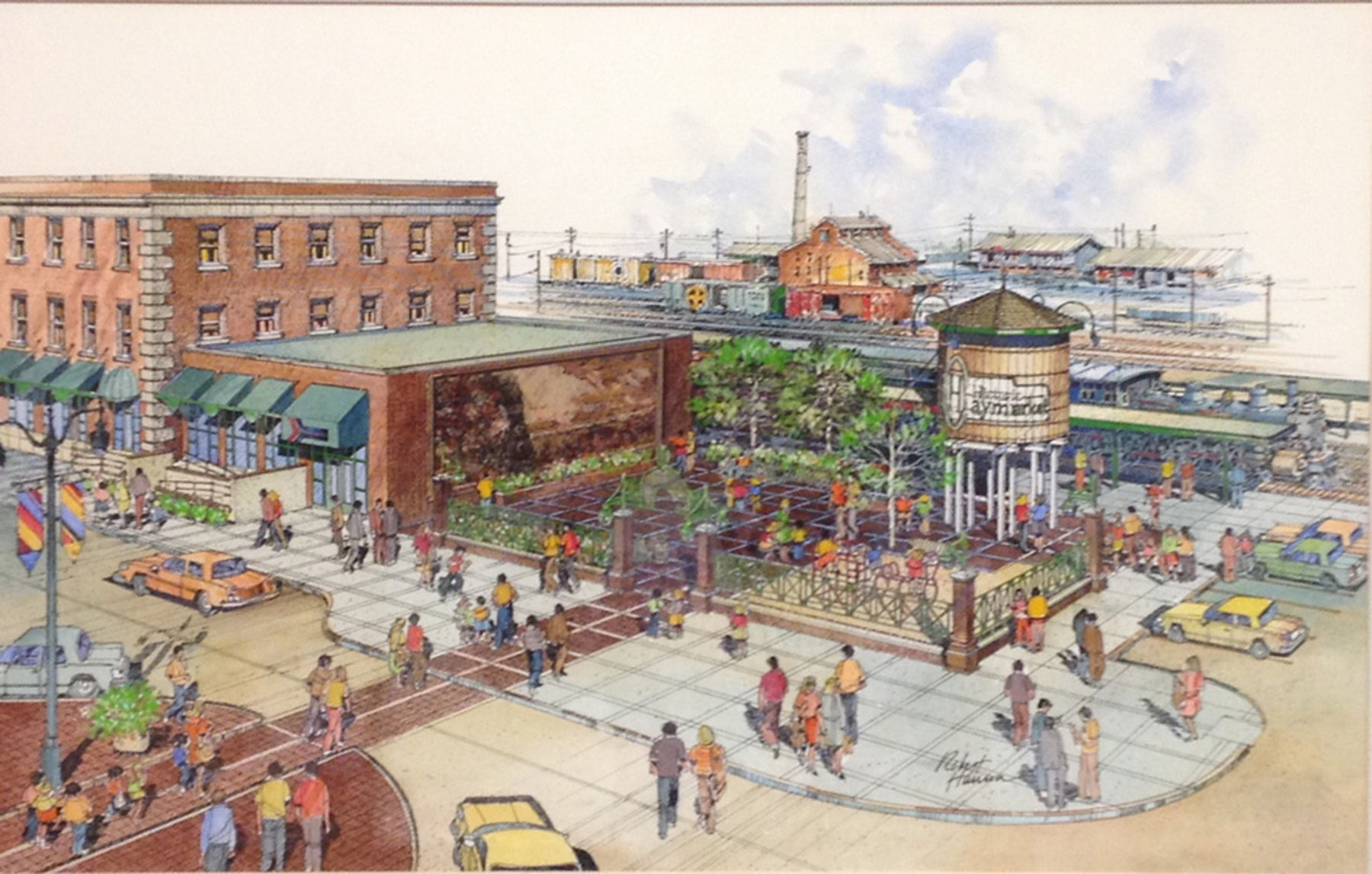1. Bill Harris Iron Horse Park & CB&Q Locomotive 710
Address
7th and Q Streets
Lincoln, NE 68508
Details
1992 (park): Erickson/Schultz, architects
1901/1926/1991 (locomotive); Havelock Shops/Shop Services, Mt. Pleasant, Iowa
Before the current Lincoln Station was constructed for Chicago, Burlington & Quincy (CB&Q) Railroad in 1927, a Railway Express building stood on the site of Iron Horse Park, north of the 1880 depot. A north addition to the train station butted up against the south wall of the Railway Express office, and when the latter was eventually demolished, it exposed a rough north wall of cinder blocks on the depot. To finish that wall and recreate the little vacant lot as a park, the City of Lincoln commissioned local sculptor Jay Tschetter to sculpt the “Iron Horse Legacy” mural of brick, carved and fired at Lincoln’s Yankee Hill Brickyard. The rest of the park was carefully designed to create a little oasis for sitting, playing on the climbing structure, and viewing the brick mural. The decorative fountain is styled after the trackside water towers that quenched thirsty locomotives in the era of steam.
The steam train adjacent to the park, CB&Q 710, was built in the Burlington Shops of the town of Havelock in 1901. Havelock grew up around the bustling Shops, which the town’s developers had courted and won with an offer of free land. Locomotive 710 first served passenger trains, then was retooled as a short-haul freight locomotive in the 1920s. By the 1950s, the steam era was ending and Burlington refurbished the steam engine and tender as a gift to the City of Lincoln in 1955. She was displayed on a hilltop in Pioneers Park until she was again refurbished in 1991 and returned to sit on Track One beside Burlington’s depot in the Haymarket.
North and west of Iron Horse Park, the former Burlington rail yard has been redeveloped into a modern complement to the historic district, including Pinnacle Bank Arena, completed in 2013. The area includes the arena’s supporting parking garages, and a mix of uses from residences to offices, bars and restaurants, and a hotel.
“The Railyard” development north of the mini-park is a two-building entertainment and dining complex bounded by Q and R Streets on the south and the north, and 7th and Canopy Streets east and west. Completed in 2013, the buildings embrace three sides of a courtyard, open to Canopy Street on the west, which is the heart of Nebraska’s first “entertainment district,” where all the establishments share a joint liquor license over the courtyard. The Railyard buildings were designed by Sinclair Hille and Encompass Architects with a more traditional, brick-clad appearance on the south and east sides, facing the historic Haymarket, and contemporary design and materials to the north and west, facing the Pinnacle Bank Arena and redevelopment area. At the south end of the Railyard, a huge computerized screen—The Cube—enlivens the space with video artwork and other programming.
Canopy Street draws its name from the western, freestanding canopy of the depot complex, which sheltered the passenger platform between Tracks 2 and 3. When Lincoln Station was built in 1927, the blue prints detailed the “old posts” salvaged from an earlier canopy built around 1905, with “new posts” added to create over 1,000 feet of covered platform from O Street north to R Street. The canopy was thoroughly renovated in 2011-13 as a central feature of the redevelopment of the former railyard west of Haymarket, providing a handsome walkway along Canopy Street and a symbolic hinge between the Historic Haymarket and the new Arena area. At the west edge of the new development, at Q Street and Arena Drive, a new Amtrak Station built in 2012-13 serves rail passengers.
Nearby Dining
- JTK Cuisine & Cocktails201 N. 7th St. (127 feet NE)
- Gate 25300 Canopy St. (185 feet SW)
- N Zone Sports Bar & Grill728 Q St. (204 feet E)
- Licorice International230 N. 7th St. (206 feet SE)
Nearby Shopping
- Burlington Antiques201 N. 7th St. (127 feet NE)
- Licorice International230 N. 7th St. (206 feet SE)
- Hillis & Company230 N. 7th St. (249 feet SE)
- Shopnoiz600 Q St. (315 feet NW)
Nearby Arts & Entertainment
- Iron Horse Park235 N. 7th St. (adjacent)
- Burlington Antiques201 N. 7th St. (127 feet NE)
- JTK Cuisine & Cocktails201 N. 7th St. (127 feet NE)
- Lincoln Station Great Hall201 N. 7th St. (127 feet NE)
Nearby Parking
- Red 1 Garage555 R St. (465 feet NE)
- Nebraska Boiler Garage803 Q St. (508 feet E)
- Green 2 Garage530 P St. (585 feet SW)
- Lumberworks Garage700 N St. (656 feet S)
